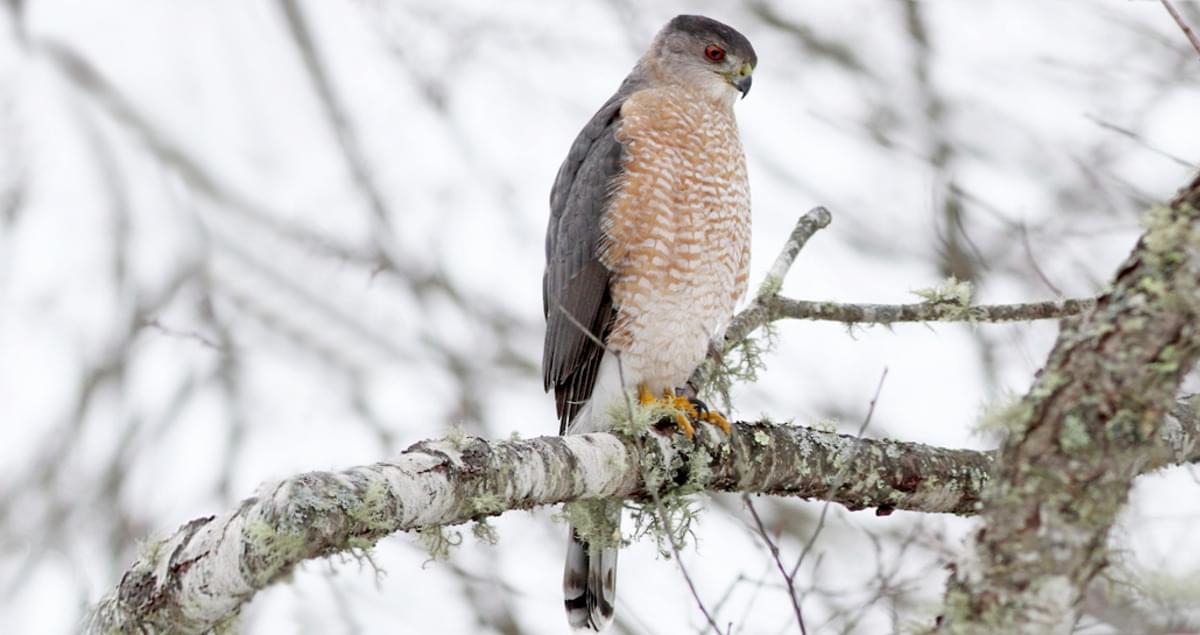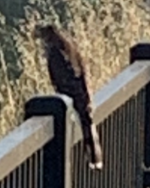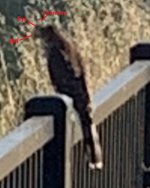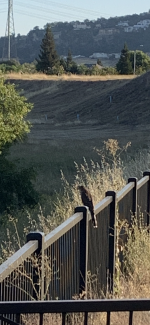-
Welcome to BirdForum, the internet's largest birding community with thousands of members from all over the world. The forums are dedicated to wild birds, birding, binoculars and equipment and all that goes with it.
Please register for an account to take part in the discussions in the forum, post your pictures in the gallery and more.
You are using an out of date browser. It may not display this or other websites correctly.
You should upgrade or use an alternative browser.
You should upgrade or use an alternative browser.
Identification help! (1 Viewer)
- Thread starter Mkellyy44
- Start date
More options
Who Replied?Deb Burhinus
Used to be well known! 😎

Welcome to Birdforum MKelly! 🙂
Cooper’s was my first impression too - apart from the obvious white tipped long tail, it looks ‘necky’ - SHHA have ‘no necks’ and a more rounded head shape than what I can see here.
Cooper’s was my first impression too - apart from the obvious white tipped long tail, it looks ‘necky’ - SHHA have ‘no necks’ and a more rounded head shape than what I can see here.
I was thinking Cooper’s hawk too because of the tail but we also get a lot of red shouldered hawks here too and it’s hard to tell them apart for me since I’m still a beginner😊 thanks for the help!Welcome to Birdforum MKelly! 🙂
Cooper’s was my first impression too - apart from the obvious white tipped long tail, it looks ‘necky’ - SHHA have ‘no necks’ and a more rounded head shape than what I can see here.
Deb Burhinus
Used to be well known! 😎

Hi MKellyI was thinking Cooper’s hawk too because of the tail but we also get a lot of red shouldered hawks here too and it’s hard to tell them apart for me since I’m still a beginner😊 thanks for the help!
A really good start with identifying the smaller birds of prey is to separate them into 3 groups; falcons, which fly very fast and have long pointed wings almost reaching the tip of tail when perched: Accipters like Sharpies and Cooper’s, that have proportionately shorter wings and long tails and when perched, their wings only reach about 1/3 down a broad banded tail. Finally, you have hawks/buteos which fly slowly on broad wings and when perched their wing reach almost to the end of a finely barred or plain tail. (Red-shouldered Hawk belongs in this last group)
This may help you - the website allows you to compare similar species side by side 🙂

Cooper's Hawk Identification, All About Birds, Cornell Lab of Ornithology
Among the bird world’s most skillful fliers, Cooper’s Hawks are common woodland hawks that tear through cluttered tree canopies in high speed pursuit of other birds. You’re most likely to see one prowling above a forest edge or field using just a few stiff wingbeats followed by a glide. With...
Downloading the picture and blowing it up - is this bird missing all the feathers on its head? Or is the photo just too grainy to tell?
The easiest way to distinguish Sharp-shinned Hawk from Cooper's Hawk in photos can be size, if you can get an accurate measure of it. If you know the size of the top rail on the fence that could give a way to judge the size of the bird.
The easiest way to distinguish Sharp-shinned Hawk from Cooper's Hawk in photos can be size, if you can get an accurate measure of it. If you know the size of the top rail on the fence that could give a way to judge the size of the bird.
Deb Burhinus
Used to be well known! 😎

Structure is easier than trying to guess size from a single image or what size a post is in the photo - when in the field when there are no other birds, size is extremely difficult to judge, even with a little experience- For someone learning to ID raptors, I would concentrate on structure, flight patterns and underwing plumage rather than size. As for identifying raptors/specifically SHHA v COHA, there are enough plumage and structural differences between them that are usually visible in an image (as is here) without worrying about fence posts imo 🙂Downloading the picture and blowing it up - is this bird missing all the feathers on its head? Or is the photo just too grainy to tell?
The easiest way to distinguish Sharp-shinned Hawk from Cooper's Hawk in photos can be size, if you can get an accurate measure of it. If you know the size of the top rail on the fence that could give a way to judge the size of the bird.
Thank you so much for the resource!Hi MKelly
A really good start with identifying the smaller birds of prey is to separate them into 3 groups; falcons, which fly very fast and have long pointed wings almost reaching the tip of tail when perched: Accipters like Sharpies and Cooper’s, that have proportionately shorter wings and long tails and when perched, their wings only reach about 1/3 down a broad banded tail. Finally, you have hawks/buteos which fly slowly on broad wings and when perched their wing reach almost to the end of a finely barred or plain tail. (Red-shouldered Hawk belongs in this last group)
This may help you - the website allows you to compare similar species side by side 🙂

Cooper's Hawk Identification, All About Birds, Cornell Lab of Ornithology
Among the bird world’s most skillful fliers, Cooper’s Hawks are common woodland hawks that tear through cluttered tree canopies in high speed pursuit of other birds. You’re most likely to see one prowling above a forest edge or field using just a few stiff wingbeats followed by a glide. With...www.allaboutbirds.org
Welcome to Birdforum MKelly! 🙂
Cooper’s was my first impression too - apart from the obvious white tipped long tail, it looks ‘necky’ - SHHA have ‘no necks’ and a more rounded head shape than what I can see here.
I would agree with this for someone learning to ID raptors, but as I said, in photos, if you can get a scale, size can sometimes be determined. In this case it is difficult to judge structure because of the quality of the photo: the breast blends into the grass in the background, the fence post hides the vent affecting the apparent length of the tail, and how 'necky' it is is impossible to judge on a bald bird. We probably all have photos like this that don't show the detail we would like. But if this was taken in the OPs garden it might be easy to measure the fence rails and from that get an idea of the size of the bird - which might (or might not) be definitive. I agree that the apparent broad white tail-tip supports a Cooper's Hawk, but I would prefer more data before making the call.Structure is easier than trying to guess size from a single image or what size a post is in the photo - when in the field when there are no other birds, size is extremely difficult to judge, even with a little experience- For someone learning to ID raptors, I would concentrate on structure, flight patterns and underwing plumage rather than size. As for identifying raptors/specifically SHHA v COHA, there are enough plumage and structural differences between them that are usually visible in an image (as is here) without worrying about fence posts imo 🙂
Deb Burhinus
Used to be well known! 😎

Some people need less data than others 😝but I would prefer more data before making the call.
I really (really) caution against using this approach of trying to establish an exact numerical size for a bird from either photos or field observation, except (perhaps) in the most extreme and desperate of circumstances. It is fraught with possibilities for error.as I said, in photos, if you can get a scale, size can sometimes be determined. In this case it is difficult to judge structure because of the quality of the photo: the breast blends into the grass in the background, the fence post hides the vent affecting the apparent length of the tail, and how 'necky' it is is impossible to judge on a bald bird. We probably all have photos like this that don't show the detail we would like. But if this was taken in the OPs garden it might be easy to measure the fence rails and from that get an idea of the size of the bird
There are a string of features that can be used in different circumstances to separate Cooper's hawk and sharp-shinned hawk, more-or-(mostly)-less definitively, but none of them is visible here. Cooper's hawk tends to look chunky, and sharp-shinned hawk dinky - and this looks more chunky than dinky. But all else is guesswork.
Deb,
I do not want to doubt your experience or ability to identify some Accipiters from a single photo. But sincerely, I just do not see some of the things you are seeing in this photo, particularly with regard to the shape of the head. Here is the photo cropped and resized. I see a bird with a small round head - because it has no feathers.

I do not want to doubt your experience or ability to identify some Accipiters from a single photo. But sincerely, I just do not see some of the things you are seeing in this photo, particularly with regard to the shape of the head. Here is the photo cropped and resized. I see a bird with a small round head - because it has no feathers.

Deb Burhinus
Used to be well known! 😎

Well you may note that it is not just me saying this looks better for Coopers than a Sharpie - 3 other experienced birders on this thread plus the OP have arrived at the same conclusion,I do not want to doubt your experience or ability to identify some Accipiters from a single photo. But sincerely, I just do not see some of the things you are seeing in this photo
Last edited:
I think it's clear that I agree with you on this point. But for different reasons...I just do not see some of the things you are seeing in this photo, particularly with regard to the shape of the head.
Here I'm sure you're wrong - I guess because you're misreading the photo - you're thinking that something in the image is the head which actually isn't the head at all. I don't see anything here to suggest a small round head, with or without feathers - certainly I don't get any hint of a bird with an unfeathered head.I see a bird with a small round head - because it has no feathers.
Here is what I see as the head, labeled. Looks like the head of a vulture. I am not suggesting it is a vulture.View attachment 1373954I think it's clear that I agree with you on this point. But for different reasons...
Here I'm sure you're wrong - I guess because you're misreading the photo - you're thinking that something in the image is the head which actually isn't the head at all. I don't see anything here to suggest a small round head, with or without feathers - certainly I don't get any hint of a bird with an unfeathered head.

Well, it is awfully difficult/impossible to tell what's going on amid all that mush, isn't it - which is the point I made earlier. But... I think (OK, I'm reasonably sure) that the end-points of your pointers are pointing at background vegetation, not bird.Here is what I see as the head, labeled.
Please indicate then, what you believe is bird and not background vegetation.Well, it is awfully difficult/impossible to tell what's going on amid all that mush, isn't it - which is the point I made earlier. But... I think (OK, I'm reasonably sure) that the end-points of your pointers are pointing at background vegetation, not bird.
Users who are viewing this thread
Total: 2 (members: 0, guests: 2)





